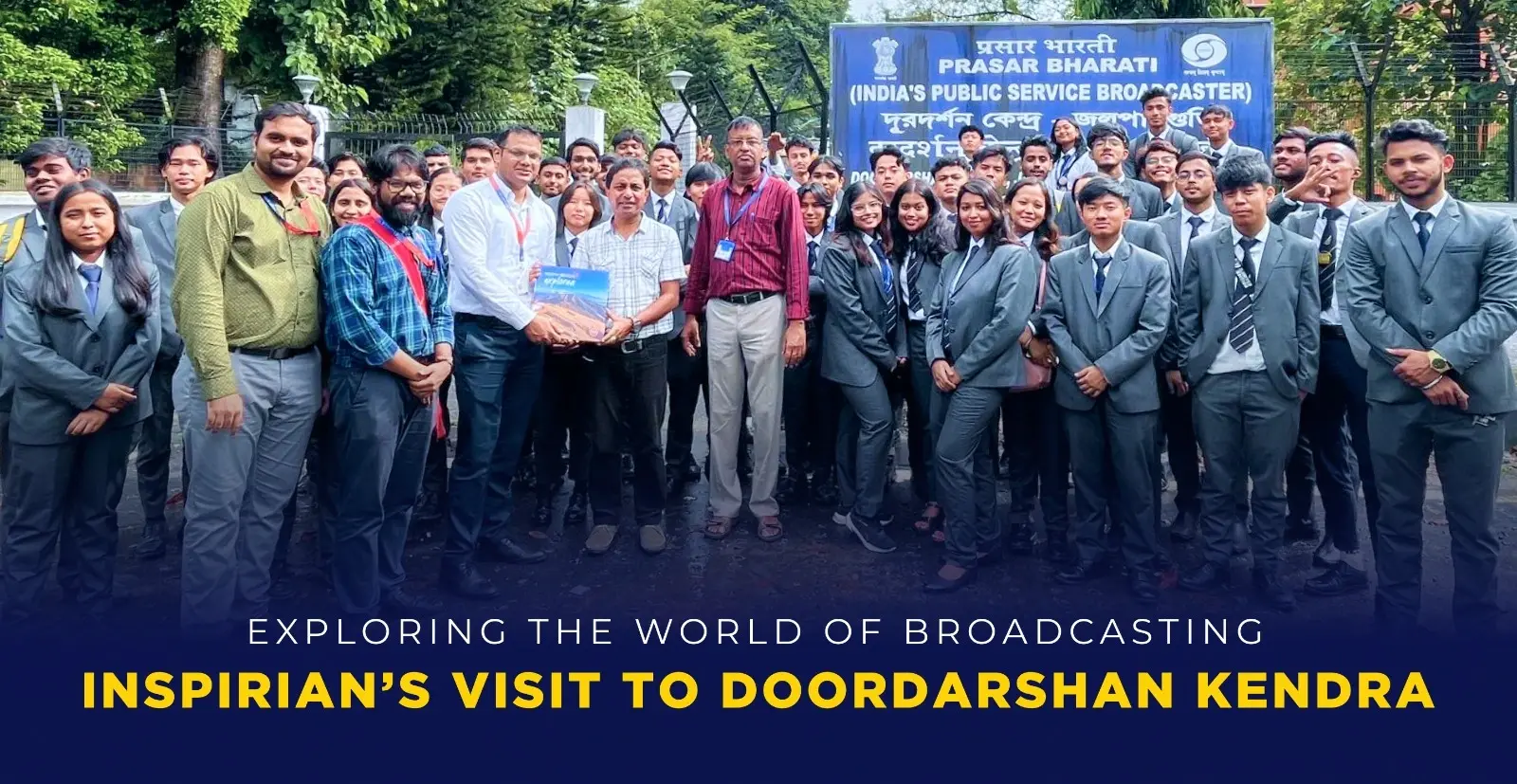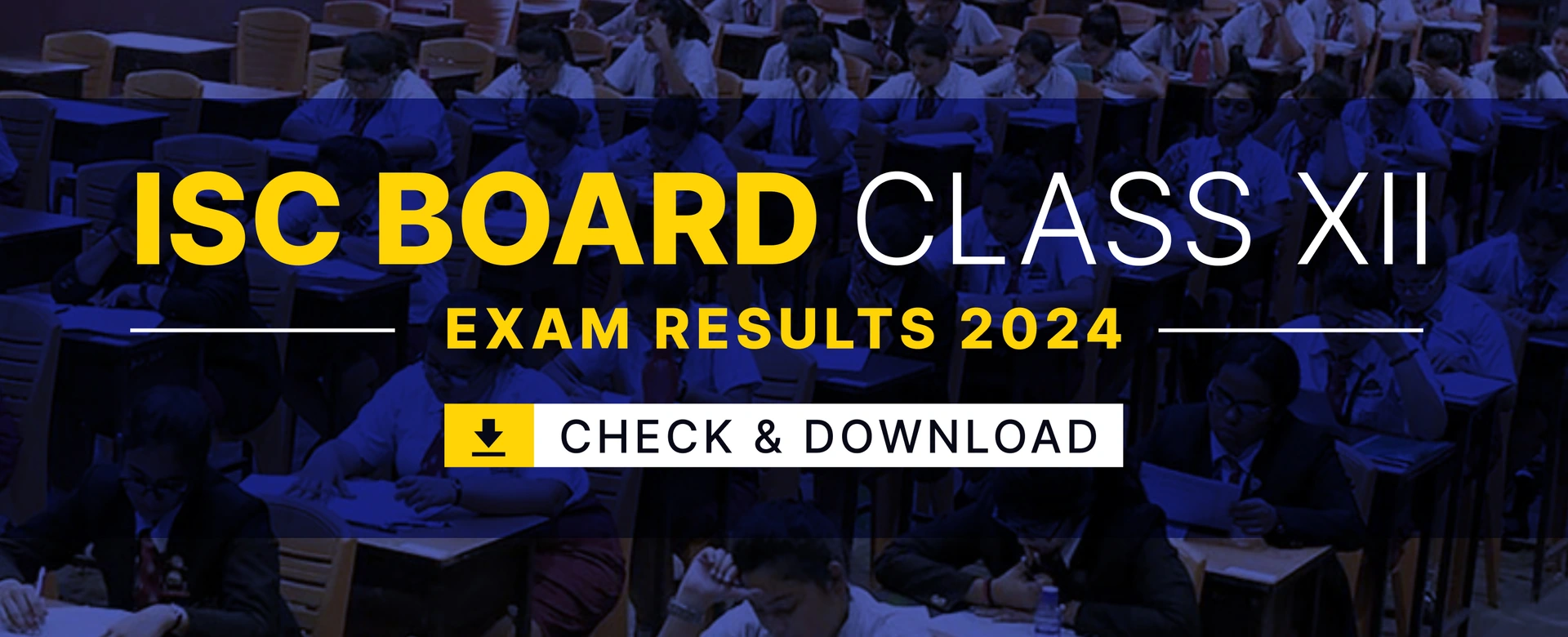Recently, On 5th October, 2023, dept. Multimedia, Animation and Graphic Design students of INSPIRIA KNOWLEDGE CAMPUS and 2 faculty members visited the Doordarshan Kendra Siliguri.
As we walked through the doors of the Doordarshan Kendra in Siliguri, the students were immediately struck by the historical charm of the place. The building itself, with its colonial architecture and lush gardens, seemed like a time capsule from another era. The Kendra has been an integral part of the region’s media landscape since its inception, and this was evident in its old-world appeal.
Significance of Doordarshan in Indian Media
Television has played an integral role in shaping our lives and connecting us to the world beyond our immediate surroundings. In India, Doordarshan Kendra has been a cherished part of our cultural fabric, and it continues to hold a special place in our hearts.
Established in 1959, Doordarshan has been a constant companion in the lives of countless Indians, providing both information and entertainment. The centre is a living reminder of this history, safeguarding its traditions and laying a strong foundation for today’s modern Indian media. Here’s how:
Market Entry and Competition: Doordarshan’s early success in capturing a vast viewership provided proof of the television medium’s potential in India. This success encouraged private entrepreneurs and businesses to invest in television broadcasting, leading to the emergence of private television channels. The competition that followed drove innovation and content diversity in the industry.
Technological Advancements: Private channels had the opportunity to learn from Doordarshan’s experiences and invest in the latest broadcasting technologies. They adopted modern production and transmission methods, which not only improved the quality of content but also pushed Doordarshan to upgrade its own technology to remain competitive.
Content Variety: As private channels entered the market, they introduced a wide range of programming to cater to diverse audience preferences. This diversity in content, including news, entertainment, sports, and niche genres, offered viewers a broader array of options, enriching the overall television experience.
Advertising and Revenue: The entry of private channels brought in new advertising revenue streams. Advertisers saw the potential to reach a larger and more segmented audience through private channels, which further encouraged investment and growth in the industry. This, in turn, enabled channels to produce high-quality content.
Global Reach: Private television channels expanded India’s reach in the global media market. The success of Indian content and the widespread diaspora allowed private channels to tap into international markets, contributing to the globalization of Indian media.
Tour of Doordarshan studio
Multimedia, Animation and Graphic Design students of INSPIRIA KNOWLEDGE CAMPUS had the incredible opportunity to visit the Doordarshan Kendra in Siliguri, West Bengal. This experience was not only a nostalgic journey through the history of Indian television but also a glimpse into the regional flavours that make Doordarshan special. Let’s explore the various aspects of Doordarshan Kendra that our BSc Animation & Multimedia encountered during their recent educational excursion.
Production Studio
One of the highlights of our visit was the guided tour of the studios. It was fascinating to witness how television shows are produced, from the control rooms filled with state-of-the-art equipment to the bustling sets where talented artists brought stories to life. The behind-the-scenes glimpse into the technical intricacies of television production was a true eye-opener. The production studio is a dedicated space with controlled lighting, sound, and acoustics. It is typically a large, open area where various sets and props can be arranged to suit the requirements of different programs like interviews, talk shows, music shows etc.
- Versatile Production Space: The studio is a dedicated space carefully designed with controlled lighting, soundproofing, and acoustics. It serves as an expansive area where various sets, props, and backdrops can be arranged to match the specific requirements of different programs, including interviews, talk shows, and music shows.
- Sophisticated Lighting: The studio is equipped with a sophisticated lighting system that can be meticulously adjusted to create various moods and atmospheres for different types of programs. This ensures that the lighting complements the content and enhances the visual quality.
- Multiple Camera Setups: Multiple cameras are strategically positioned within the studio to capture a variety of angles and shots. These cameras can be remotely controlled and operated by skilled camera operators who work to capture the action during recordings. This multi-camera setup allows for dynamic and engaging visual storytelling.
- Audio Quality: High-quality audio is crucial for professional television production. The studio features top-notch microphones, mixing consoles, and soundproofing to capture and manage audio effectively. Sound engineers in the studio ensure that audio levels and quality meet the highest standards.
- Versatile Sets and Props: Sets, props, and backdrops can be quickly and creatively arranged within the studio to transform it into different environments as required by various programs. Whether it’s set up as a newsroom, talk show set, or a fictional location, the studio is adaptable to suit the specific needs of each show.
- Control Room Connection: The studio is closely connected to a control room where technical directors and production staff oversee the entire production process. In the control room, advanced video and audio mixing consoles, monitors, and communication systems are utilized to manage the equipment, camera feeds, audio, and the overall production flow.
- Real-Time Monitoring: The studio is equipped with monitors and playback equipment that allow the production team to view the live footage and review recorded material in real-time. This feature ensures that the content is captured correctly and meets production standards.
Post Production Studio
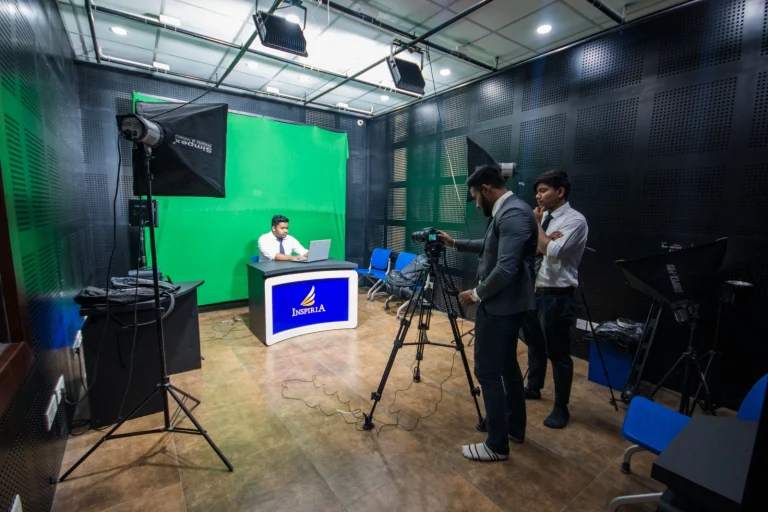
The post-production room in Doordarshan Kendra is a critical facility where recorded video and audio content is edited, enhanced, and prepared for final broadcast.
- Video Editing Stations: Post-production rooms are equipped with powerful video editing workstations that feature advanced software for video editing, including tools for cutting, splicing, adding effects, and more.
- Non-Linear Editing (NLE) Software: Skilled video editors use NLE software, such as Adobe Premiere Pro, Final Cut Pro, or Avid Media Composer, to manipulate and edit video footage.
- Audio Editing Workstations: In addition to video editing, post-production rooms have audio editing workstations with software like Adobe Audition or Pro Tools. This is essential for enhancing the audio quality of the content.
- High-Quality Monitors: High-resolution and colour-calibrated monitors are used to accurately view and edit video content. This ensures that the final product meets professional quality standards.
- Video and Audio Servers: The post-production room is often linked to servers where raw and edited video and audio files are stored. This allows for easy access to source materials and project files.
- Digital Effects and Graphics Workstations: Some post-production rooms have workstations dedicated to creating digital effects, animations, and graphics. This is important for adding special effects to programs and enhancing visual appeal.
- Colour Correction Equipment: Color correction equipment, including hardware and software, is used to ensure that the colour balance and consistency are maintained throughout the video content.
- Sound Mixing and Engineering Equipment: To guarantee high-quality audio, post-production rooms may have sound mixing and engineering equipment, including audio mixers and hardware for adjusting audio levels, equalization, and effects.
- Rendering and Exporting Stations: After editing, content is rendered and exported into the appropriate format for broadcast. These stations may feature high-performance computers optimized for rendering tasks.
The post-production room is where the raw footage from the production studio is transformed into a polished and broadcast-ready format. It’s here that skilled video and audio editors work diligently to ensure that the content meets professional quality standards and is prepared for transmission to viewers on Doordarshan Kendra channels.
Live Editing Room

Live editing or real-time video editing, is an essential aspect of television production in Doordarshan Kendras and other broadcasting facilities. It involves the immediate editing and processing of video and audio content as it’s being recorded or broadcast live. For that, they have:
- Control Room: Live editing is typically performed in the control room, which is a central hub for coordinating all technical aspects of a live broadcast. The control room is equipped with video and audio mixing consoles, monitors, and communication systems.
- Vision Mixer (Video Switcher): The vision mixer, also known as a video switcher, is a critical component of live editing. It allows operators to select and switch between various video sources in real time. This is important for creating dynamic live broadcasts with multiple camera angles, graphics, and effects.
- Live Graphics and Overlays: Live broadcasts often feature graphics, lower thirds, on-screen text, and other visual elements. Live editors use graphics and overlay systems to add these elements to the broadcast in real time.
- Audio Mixing: Live editing includes real-time audio mixing to ensure clear and balanced sound. Audio engineers adjust microphone levels, apply effects, and control audio sources to maintain high audio quality.
- Instant Replay: In live sports broadcasts, instant replay systems allow editors to quickly review and replay key moments of the game for analysis and audience engagement.
- Live Transitions: Transitions, such as dissolves or wipes, are used to smoothly transition between different video sources or scenes during live broadcasts.
- Live Interviews: During live talk shows or interviews, live editing ensures that the conversation flows smoothly, and multiple camera angles are used to capture all participants.
Uplink and Downlinking Room
Uplink and downlink rooms play crucial roles in ensuring the successful transmission of audio and video signals to and from remote locations, such as broadcast satellites, news bureaus, or other studios. These rooms are essential for live broadcasts, news reporting, and many other media-related activities.
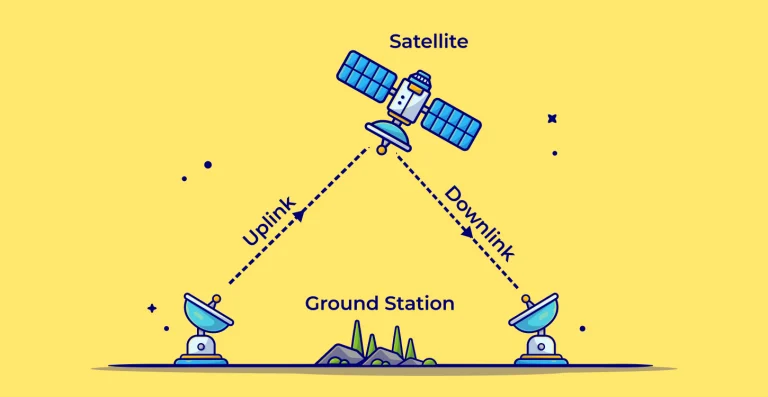
Uplink Room
In a Doordarshan Kendra, the uplink room serves as the point where signals originating from the Kendra are transmitted to a satellite. This process involves encoding and modulating the signals, which can encompass a variety of content such as television programs, live broadcasts, and more. The uplink room is equipped with satellite antennas, often large parabolic dishes, that are utilized to transmit these signals to the satellite.
Within the room, there is essential uplink equipment including satellite modulators, encoders, and amplifiers, which are responsible for preparing the content for transmission. These systems play a pivotal role in ensuring that the transmitted signals are of high quality and can be effectively received by the satellite. Doordarshan Kendras meticulously manage a schedule for uplinking various programs, including news broadcasts, live events, and pre-recorded shows. This scheduling ensures the seamless transmission of content.
Downlink Room
Conversely, the downlink room in a Doordarshan Kendra is responsible for receiving signals from the satellite. It features satellite dish antennas pointed at the same satellite used for uplinking. The downlink equipment includes satellite receivers and demodulators, which are instrumental in capturing and demodulating the satellite signals. This process is essential as it converts the received signals into a format that can be readily used for broadcast. The signals are then decoded and distributed to the appropriate broadcast and control systems. The downlink room also includes monitoring equipment to ensure the quality and stability of the received satellite signals. Technicians continuously monitor the signals to detect and address any issues that may arise swiftly.
DVR Room
In a Doordarshan Kendra, the DVR (Digital Video Recorder) room, also known as the Master Control Room (MCR) or Central Apprehension Room (CAR), serves as a critical hub for managing and controlling the broadcast of pre-recorded video content.
The DVR room is equipped with multiple video playback devices, such as digital video servers, professional video tape recorders, and other hardware and software systems designed to play pre-recorded video content.
The DVR room maintains a comprehensive content library, which includes recorded programs, advertisements, public service announcements, and other video content ready for broadcast. This content may be stored on various media, including hard drives, optical discs, and digital storage servers.
New video content, such as programs or advertisements, is ingested into the DVR system. This involves transferring content from external sources (such as tape, digital files, or satellite feeds) into the digital storage system for playback.
The DVR room in a Doordarshan Kendra plays a central role in ensuring the smooth and continuous broadcast of pre-recorded content. Technicians and operators in this room work diligently to maintain the quality of broadcasts and adhere to the broadcast schedule.
Regional Flavor of Doordarshan Kendra
One of the most striking aspects of our visit was the unique regional flavour that Doordarshan Kendra in Siliguri brings to the Indian television landscape. The Kendra produces and broadcasts programs that showcase the rich culture, traditions, and diversity of the North Bengal region. It’s a reminder of how Doordarshan has been instrumental in preserving and promoting local culture and talent.
- Pioneer of Television Broadcasting: Doordarshan was India’s first television network, bringing the concept of television to millions of households. It played a crucial role in introducing the Indian populace to the world of visual media.
- Cultural and Social Impact: Doordarshan has been a significant source of entertainment and information for generations. It has played a crucial role in preserving and promoting Indian culture and heritage through programs like “Rangoli,” “Ramayana,” and “Mahabharata,” which became iconic and brought people together in front of their television sets.
- Educational Content: Doordarshan has produced and broadcast educational programs, documentaries, and news segments that have contributed to the dissemination of knowledge and awareness across the nation. Programs like “Krishi Darshan” have been instrumental in educating farmers about modern agricultural practices.
- News and Current Affairs: DD News, the news division of Doordarshan, has been a reliable and credible source of news for decades. It provides news coverage, including regional news, and has played a vital role in keeping the public informed.
- National Integration: Doordarshan has been instrumental in promoting national integration by broadcasting programs in multiple languages and showcasing the diversity of Indian culture. It has served as a unifying force, especially in a country with numerous languages and cultural variations.
- Government Communication: Doordarshan serves as a crucial medium for the government to communicate its policies, programs, and initiatives to the public. It plays a central role in disseminating public service messages and campaigns.
Takeaway for the students from the tour
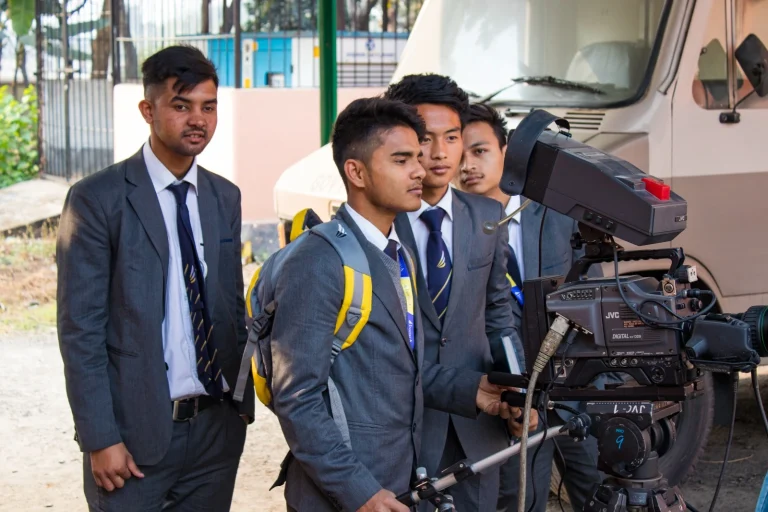
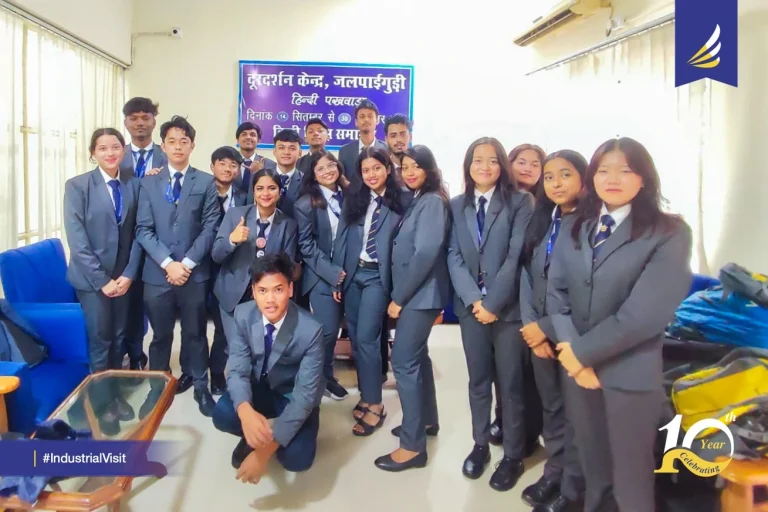
In conclusion, our visit to Doordarshan Kendra Siliguri with the students was an enriching and enlightening experience. Witnessing the intricate workings of a broadcasting centre firsthand provided valuable insights into the world of media and television production.
The tour not only exposed the students to cutting-edge technology but also highlighted the meticulous planning and coordination required to bring television programs to life. From the production studios where creativity takes shape to the control rooms where technical expertise ensures seamless broadcasting, every aspect of the visit was educational and inspiring.
Engaging with professionals in the field, the students had the opportunity to ask questions, understand the behind-the-scenes processes, and gain a deeper appreciation for the complexities of television production. The visit sparked curiosity and encouraged the students to consider future careers in media, post-production, live editing or related fields.
Moreover, the trip fostered a sense of enthusiasm and curiosity among the students about the media industry. Observing the dedication and passion of the Doordarshan Kendra Siliguri team left a lasting impression, inspiring our students to explore their own creative potential.
This visit was not just a field trip; it was a journey of discovery and learning, providing our students with valuable insights that will undoubtedly shape their future endeavours.

